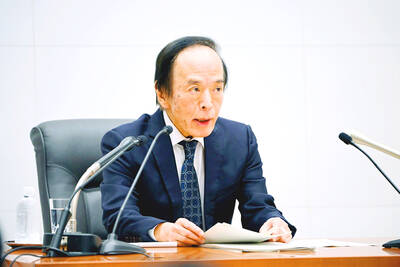Offshore operations of the local financial sector reported a more than 14 percent fall in pretax profits from a year earlier in the first seven months of the year, as high US dollar interest rates boosted their costs, the Financial Supervisory Commission (FSC) said last week.
The combined pretax profits of offshore banking units (OBUs), offshore insurance units (OIUs) and offshore securities units (OSUs) totaled US$989 million, down 14.5 percent from a year earlier, data compiled by the commission showed.
Pretax profits posted by OBUs totaled NT$32.12 billion (US$1 billion), down 12.6 percent from a year earlier, the commission said.

Photo: Kelson Wang, Taipei Times
After an aggressive rate hike cycle by the US Federal Reserve last year, interest levels in US dollar-denominated assets have stayed high, which pushed up costs of interbank lending shouldered by OBUs, Banking Bureau Deputy Director-General Phil Tung (童政彰) said.
In the first seven months, the balance of deposits received by OBUs rose to NT$3.67 trillion, up 2.9 percent from a year earlier, and the balance of lending totaled about NT$2.40 trillion, up 7 percent year-on-year with the average deposit-to-lending ratio at 65.3 percent, the commission said.
However, the highest interest income due to a rate hike cycle in the US allowed OIUs to increase their interest income, Insurance Bureau Deputy Director-General Tsai Huo-yen (蔡火炎) said.
The combined pretax profits of OIUs was US$16 million, representing a 10.6-fold increase from a year earlier at a time when OIUs of life insurance companies, non-life insurance firms and re-insurers saw their profitability continue to improve, the commission said.
The increase also came from a relatively low comparison base last year as insurance companies had to pay massive compensation to insurance policyholders due to climate change, Tsai said.
However, the number of insurance contracts sold by OIUs in the first seven months fell 18.1 percent year-on-year to 416, with premium income plunging 87.9 percent to US$3 million, the commission said.
The sharp drop in the number of new contracts and premium income reflected caution among OIUs which appeared reluctant to sign a large number of new contracts after paying huge compensation last year, Tsai said.
Many OIU clients terminated their contracts ahead of schedule or declined to renew their contracts, Tsai said.
Combined pretax losses for OSUs were less than US$3 million, down almost US$10 million from a year earlier, the commission said.
The improvement showed many securities firms parked their funds in bonds commanding higher yields after their previous bond investments matured, Securities and Futures Bureau Deputy Director Kao Ching-ping (高晶萍) said.

Taiwan’s long-term economic competitiveness will hinge not only on national champions like Taiwan Semiconductor Manufacturing Co. (TSMC, 台積電) but also on the widespread adoption of artificial intelligence (AI) and other emerging technologies, a US-based scholar has said. At a lecture in Taipei on Tuesday, Jeffrey Ding, assistant professor of political science at the George Washington University and author of "Technology and the Rise of Great Powers," argued that historical experience shows that general-purpose technologies (GPTs) — such as electricity, computers and now AI — shape long-term economic advantages through their diffusion across the broader economy. "What really matters is not who pioneers

In a high-security Shenzhen laboratory, Chinese scientists have built what Washington has spent years trying to prevent: a prototype of a machine capable of producing the cutting-edge semiconductor chips that power artificial intelligence (AI), smartphones and weapons central to Western military dominance, Reuters has learned. Completed early this year and undergoing testing, the prototype fills nearly an entire factory floor. It was built by a team of former engineers from Dutch semiconductor giant ASML who reverse-engineered the company’s extreme ultraviolet lithography (EUV) machines, according to two people with knowledge of the project. EUV machines sit at the heart of a technological Cold

TAIWAN VALUE CHAIN: Foxtron is to fully own Luxgen following the transaction and it plans to launch a new electric model, the Foxtron Bria, in Taiwan next year Yulon Motor Co (裕隆汽車) yesterday said that its board of directors approved the disposal of its electric vehicle (EV) unit, Luxgen Motor Co (納智捷汽車), to Foxtron Vehicle Technologies Co (鴻華先進) for NT$787.6 million (US$24.98 million). Foxtron, a half-half joint venture between Yulon affiliate Hua-Chuang Automobile Information Technical Center Co (華創車電) and Hon Hai Precision Industry Co (鴻海精密), expects to wrap up the deal in the first quarter of next year. Foxtron would fully own Luxgen following the transaction, including five car distributing companies, outlets and all employees. The deal is subject to the approval of the Fair Trade Commission, Foxtron said. “Foxtron will be

INFLATION CONSIDERATION: The BOJ governor said that it would ‘keep making appropriate decisions’ and would adjust depending on the economy and prices The Bank of Japan (BOJ) yesterday raised its benchmark interest rate to the highest in 30 years and said more increases are in the pipeline if conditions allow, in a sign of growing conviction that it can attain the stable inflation target it has pursued for more than a decade. Bank of Japan Governor Kazuo Ueda’s policy board increased the rate by 0.2 percentage points to 0.75 percent, in a unanimous decision, the bank said in a statement. The central bank cited the rising likelihood of its economic outlook being realized. The rate change was expected by all 50 economists surveyed by Bloomberg. The